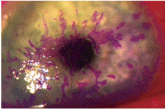 Q: A 13-year-old patient presented with bilateral herpes simplex. How common is this? Do I need to worry about an occult malignancy?
Q: A 13-year-old patient presented with bilateral herpes simplex. How common is this? Do I need to worry about an occult malignancy?
A: Bilateral herpes is extremely rare in any age group unless the patient is immunosuppressed, says Eric Donnenfeld, M.D., of Ophthalmic Consultants of Connecticut and
Most often, the patients immunosuppression will be caused by atopic disease. If this patient was to have some form of atopy, there would be no reason for any further evaluation as to the possibility of malignancy, says Dr. Donnenfeld.
For example, in one small study, five patients with bilateral herpes simplex virus (HSV) demonstrated systemic atopy, while only two presented with immune disorders.1 Patients with asthma or allergies have immunosuppression that significantly increases their risk of developing bilateral herpes simplex, says Dr. Donnenfeld.
The incidence of bilateral HSV keratitis has been reported to be from 1.3% to 12% of adult herpes simplex virus ocular infections, but in children under the age of 18, the incidence has been reported to be as high as 26%, says Lawrence Gans, M.D., of SureVision Eye Centers in St. Louis, Mo.2 When investigating for systemic atopy, he says, make sure to obtain a full medical history for the patient. The pediatrician can be very helpful in this regard.
Rose bengal staining of a herpes simplex dendrite.
Other, more rare conditions might be part of the cause of the patients immunosuppression. Systemic atopy, commonly associated with bilateral HSV cases in children, is presumably related to depressed T-cell function, says Dr. Gans. Rare conditions, such as Wiskott-Aldrich syndrome, a sex-linked congenital immunodeficiency disease with both humoral and cellular disorders, are strongly associated with bilateral recurrent HSV keratitis. But something like this would be noted shortly after birth, rather than later in adolescence.

Courtesy: Eric Donnenfeld, M.D.
If you rule out atopy, check the patients medical history for a course of corticosteroids, risk of human immunodeficiency virus (HIV) infection or chance of malignancy, in that order, Dr. Donnenfeld says.
If the patient is taking corticosteroids, this also may be the cause of the patients immunosuppression, Dr. Donnenfeld adds. A patient on oral corticosteroids, such as prednisone, would also be immunosuppressed and be at risk of developing bilateral herpes simplex.
At this point, though, if the source of the immunosuppression has not been determined, send the patient to an internist or pediatrician for further evaluation, he adds.
In very rare cases, the patients immunosuppression may stem from HIV. In general, HSV keratitis does not appear to be more common or more often bilateral in HIV-infected patients, although the infection may be more prolonged and the recurrences may be more frequent when it does occur, says Dr. Gans.
If this is your suspicion, refer the patient to the primary care practitioner and communicate your concerns to that doctor.
With HIV, its rare that it would be from sexual contact at age 13, so a history of transfusion is more likely, which means they may not know they have it, says Dr. Donnenfeld.
The lastand least likelypossibility is that this patient does indeed have an occult malignancy. However, this is a very slim chance, say both Drs. Donnenfeld and Gans. And, just because it is unlikely does not mean you can relax your guardthe likelihood of an occult malignancy may increase with age.
1. Souza PM,
2. Choudhary A, Higgins G, Kaye SB. Herpes Simplex Keratitis and Related Syndromes. In: Reinhard T, Larkin DFP (eds). Cornea and External Eye Disease.

